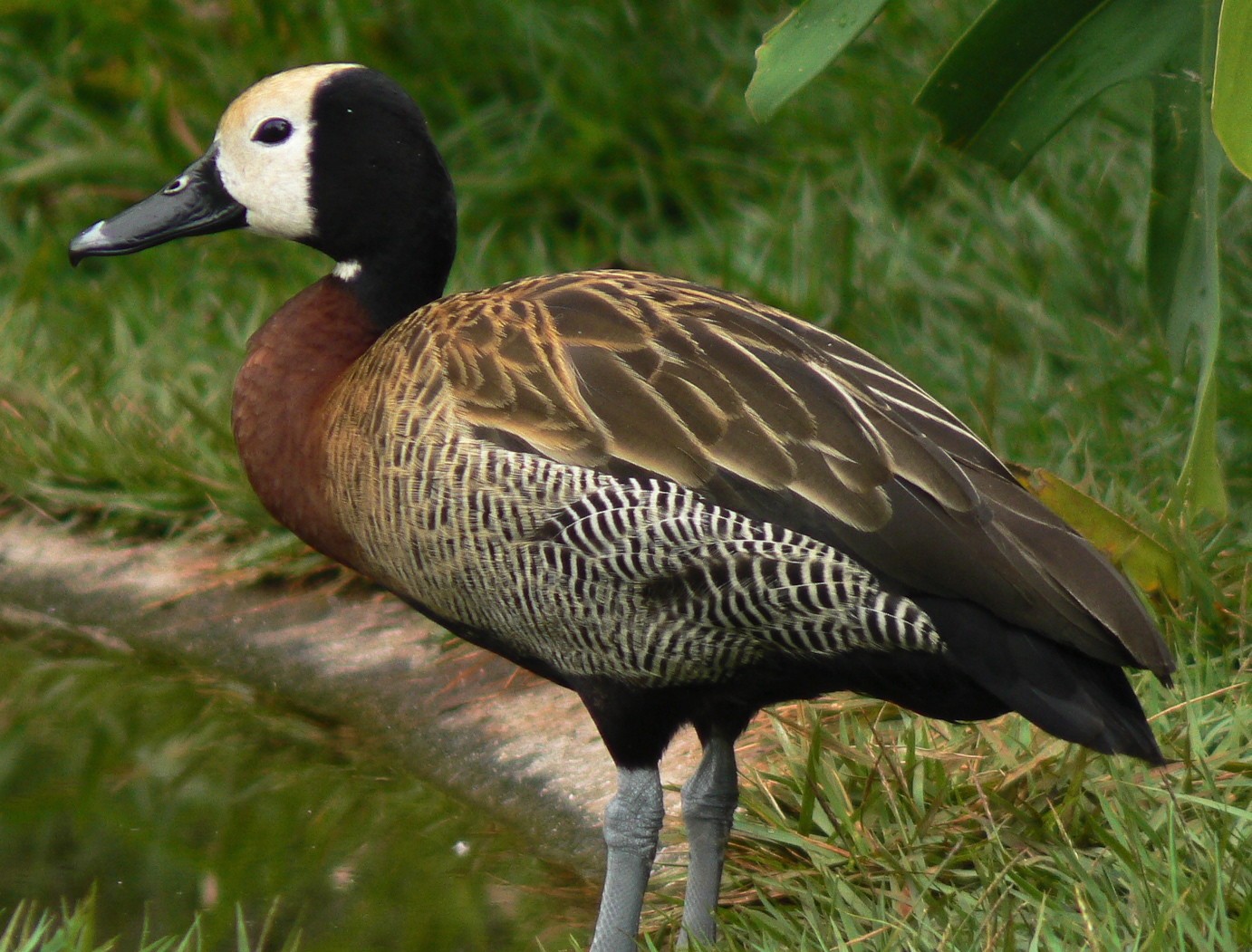
White-faced whistling duck(Dendrocygna viduata)
Phylum —chordata
Class — aves
Order — anseriformes
Family — anatidae
Genus –dendrocygna
Appearance
White-faced whistling duck adult males have the front half of their head and throat white and the rest of their head and neck are black with white patches on the underside of the neck the lower neck and wing shoulders are chestnut; their flanks are barred black on white the rest of the underparts, underside of wings, the rump and tail are black. Their back and scapulars are olive brown edged with golden buff, eyes are brown, the bill is black, feet, toes and webs are blue with black markings.
The female is similar but has the front of the head and neck spot tinged with rust color. Although it has the long neck and long legs of other tree ducks, it does not spend much time perched in trees but prefers sand banks. It behaves more like a goose or swan than a typical duck.
Length – 14-18 inches, weight – 1-2 pounds.
Habitat
The white-faced whistling duck has a peculiar disjunctive distribution, occurring in Africa and South America.
Behavior
It is a highly social species with flocks often numbering in the hundreds. Mutual preening is highly developed and is important for permanent pair bonding. They are often found in association with the fulvous whistling duck.
It vocalizes frequently with distinctive high-pitched, multisyllabic whistles which sound very unduck-like. Male and female calls differ slightly and may be a bonding mechanism.
They are usually in flocks. They spend a lot of time sitting on the banks. Most foraging activity takes place at night; during the day the birds roost near the water, often in flocks of several hundred, and preen themselves and others.
Diet
White-faced whistling ducks eat underwater tubers and seeds of aquatic plants, also mollusks, small aquatic animals and invertebrates such as aquatic insects, they commonly obtain their food by diving.
Reproduction
Nests are built of leaves on the ground in marshes and also in hollow trees. Mutual preening plays an important part in the formation of pairs and maintenance of bonds. Clutches consist of 6 to 12 eggs, and both partners incubate the eggs for 28 to 30 days. The ducklings are often hidden in aquatic vegetation by the parents.
In captivity
Lifespan can reach 20 years.
Ducks of this genus are social species that get along peacefully with representatives of their own genus and those ones of other genera in large mixed groups on the same site, so it is possible to keep birds of different species in one spacious aviary outside the breeding season. It is only advisable to make sure that these are ducks of approximately the same size, since larger ones can make smaller ones go away from the feeder and drinker.
Ducks feel great on the territory where there are tall grasses, shrubs and trees and a reservoir at least 1 m deep, the size of which allows them to swim. The area of the fenced yard should correspond to the number of birds contained, providing it with the opportunity to retire and hide. Small shelters on the top of the open area in the form of sheds, huts and booths are necessary as shelters from birds of prey, bad weather, as well as for overnight stays. Building aviaries, you should take into account the desire of the bird to fly. Owners usually cover them from above or make regular trimming of the wings.
In winter, ducks, being mainly tropical inhabitants, need reliable protection from the cold. Capital buildings with deep straw bedding or a thick layer of sawdust will protect the bird from hypothermia and frostbite in the winter. Depending on the severity of the climate, it is necessary to provide a variety of ways to warm up the winter room when the temperature drops from 0 оС and below.
Wood ducks are mostly monogamous and nest in colonies, but during the breeding season it is necessary to settle birds of different species to avoid hybridization. Mixing of species occurs rarely, and only when there is an excess of sexually mature males that do not have a permanent pair. On the nesting site, various locations are organized for laying eggs: boxes and houses on the ground,which also can be raised 1 meter or higher from its surface.
It is quite simple to provide full nutrition to wood ducks in captivity. A variety of grain mixes and pellets are suitable for feeding them. Ducks need drinkers with a sufficient amount of clean water, especially if there is not even a small pond for swimming.
Ducklings grow well when the keepers start giving them standard feeds, and enjoy eating chopped lettuce or spinach leaves. Artificially bred сhicks sometimes do not eat well during their first days, so keepers add boiled eggs or mealworms to their food. It is important to provide pairs of ducks with a brood with the opportunity to graze on fresh grass or give access to shallow reservoirs overgrown with aquatic vegetation (duckweed, reeds, etc.). Such conditions of keeping contribute to better preservation and growth of young birds. Daily bathing under the control of adult birds is safe.
 Russian
Russian
 English
English
























